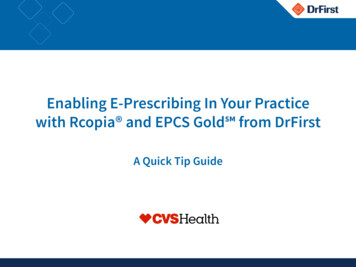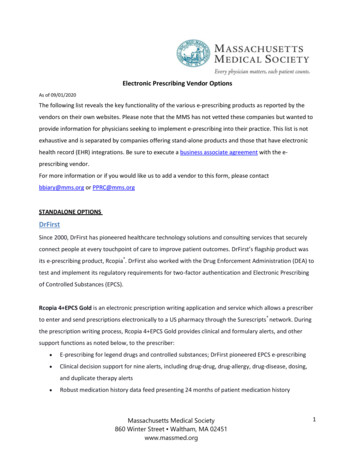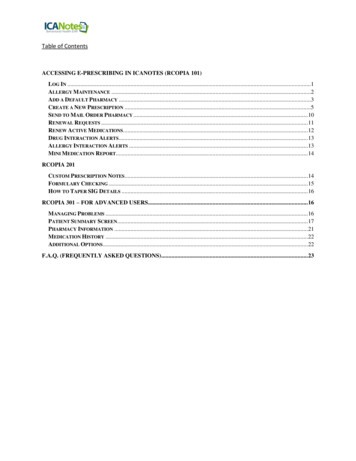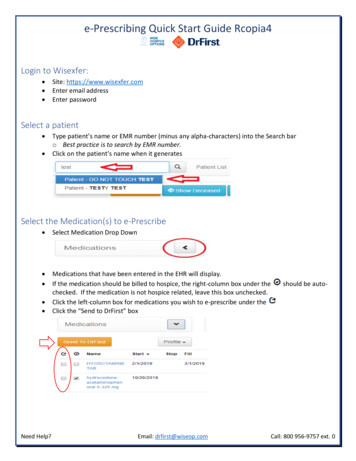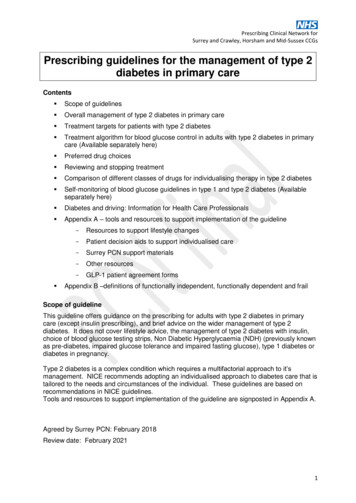
Transcription
Prescribing Clinical Network forSurrey and Crawley, Horsham and Mid-Sussex CCGsPrescribing guidelines for the management of type 2diabetes in primary careContents Scope of guidelines Overall management of type 2 diabetes in primary care Treatment targets for patients with type 2 diabetes Treatment algorithm for blood glucose control in adults with type 2 diabetes in primarycare (Available separately here) Preferred drug choices Reviewing and stopping treatment Comparison of different classes of drugs for individualising therapy in type 2 diabetes Self-monitoring of blood glucose guidelines in type 1 and type 2 diabetes (Availableseparately here) Diabetes and driving: Information for Health Care Professionals Appendix A – tools and resources to support implementation of the guideline -Resources to support lifestyle changes-Patient decision aids to support individualised care-Surrey PCN support materials-Other resources-GLP-1 patient agreement formsAppendix B –definitions of functionally independent, functionally dependent and frailScope of guidelineThis guideline offers guidance on the prescribing for adults with type 2 diabetes in primarycare (except insulin prescribing), and brief advice on the wider management of type 2diabetes. It does not cover lifestyle advice, the management of type 2 diabetes with insulin,choice of blood glucose testing strips, Non Diabetic Hyperglycaemia (NDH) (previously knownas pre-diabetes, impaired glucose tolerance and impaired fasting glucose), type 1 diabetes ordiabetes in pregnancy.Type 2 diabetes is a complex condition which requires a multifactorial approach to it’smanagement. NICE recommends adopting an individualised approach to diabetes care that istailored to the needs and circumstances of the individual. These guidelines are based onrecommendations in NICE guidelines.Tools and resources to support implementation of the guideline are signposted in Appendix A.Agreed by Surrey PCN: February 2018Review date: February 20211
Overall management of Type 2 Diabetes in Primary Care:DiagnosisHbA1c 48 mmol/mol (6.5%) OR Fasting glucose 7 mmol/L(Note: don’t use HbA1c if rapid rise in blood sugar/increased red cell turnover/pregnancy/anaemia/haemaglobinopathies)If asymptomatic repeat test two weeks apartManagement Patient support andlifestyle advice (signpostto resources in Appendix A) Dietary advice(be sensitive to the person’sneeds, culture and beliefs) Refer to structured education programme e.g. DESMOND, at diagnosis with regularreinforcementIf overweight aim to reduce weight by 5-10%, but any weight loss is beneficialIncrease physical activity and offer stop smoking supportErectile dysfunction –ask men about this annually. For treatment see Surrey PCNguidanceDiscuss contraception and pregnancy in women under 50 yrsEncourage review of carbohydrate intake and individualise recommendations forcarbohydrate and alcohol intake, meal patterns and portion controlRecommend slow release high fibre foods e.g. fruit and vegetables, whole grains,pulsesInclude oily fish and low fat dairy in the dietReduce processed foods (including meats) and overall fat intake from all sourcesUse of foods specifically for people with diabetes is unnecessaryReducing Cardiovascular Riskst1 Line:Blood pressure(see table over page for BPtreatment target)LipidsSee Surrey PCN guidanceBlood glucose(see table over page forindividualising blood glucosetreatment targets)ACE inhibitor (because of renal benefits) If intolerant of ACEI tryan ARBAfrican or Caribbean origin: use ACEI plus indapamide or CalciumChannel Blocker (CCB)Use CCB in women who may become pregnantnd2 LineAdd CCB or indapamiderd3 LineACEI plus CCB plus indapamideth4 LineAdd low dose spironolactone or bisoprolol or doxazosinPrimary preventionOffer Atorvastatin 20mg, if QRISK2 10%SecondaryAtorvastatin 80mg.prevention Individualise HbA1c, treat the patient not the target (see table 1 for advice ontreatment targets) Relax target if on treatment associated with hypoglycaemia Lifestyle is crucialIntensify treatment if 48 mmol/mol (6.5%) on lifestyleHbA1c 58 mmol/mol (7.5%) on any drug therapy, or according toindividualised targetTarget after48 mmol/mol (6.5%) on lifestyle and single drug therapy aloneintensifying(except SU or repaglinide)treatment, HbA1c 53 mmol/mol (7%) on multiple drug therapy (or SU monotherapy),or according to individualised targetManaging complicationsFoot careAutonomicneuropathy(think about symptoms andmanage)Peripheral neuropathyRenal and eye diseaseAt initial foot screening – give foot education leaflet with information on how to self-referAnnual examination for risk factors and stratification of risk:o Neuropathy (use 10g monofilament)o Evidence of ischaemiao Ulceration, callouses, infection or gangreneo Deformity, Charcots arthropathyRefer if one or more of the above is present Reduced hypo awareness or highly fluctuating blood glucose control Unexplained bladder emptying Gastrointestinal symptoms: gastroparesis, diarrhoea Consider referral to specialist service for overall management adviceTight glycaemic control may reduce progression of neuropathySee Surrey PCN treatment guidelines for diabetic neuropathyBP target is lower in renal and eye disease 130/80NICE guidelines on CKD, managing complications in type 2 diabetes2
Patient review Check adherence to diet, lifestyle and medication Assess emotional and psychological needs Review and consider stopping treatments that are not working Consider substituting with an alternative hypoglycaemic agent Review HbA1c target Assess hypoglycaemia risk Reinforce importance of diet and lifestyle changes CV risk managed Check patient has attended retinopathy screening Check feet Kidney function – eGFR and albumin:creatinine ratio (ACR)At Review1.2.3.4.5.6.7.8.Remember the 8 careprocesses!Blood glucose controlBlood pressureSerum CholesterolSerum CreatinineUrine albumin / creatinine ratioFoot risk surveillanceBody Mass IndexSmoking HistoryTreatment targets for patients with type 2 diabetesHbA1c targetoHealth statusHealthy (Lifestyle, diet andsingle drug Rx, except sulphonylureaor repaglinide))On multiple drug Rx, orsingle drug Rx with sulphonylurea orrepaglinideoDiscuss and agree individual HbA1ctarget with the patientRelax target based on individualcircumstancesBlood pressuretarget (mmHg)* 130/80 if there isCholesterolSee Surrey PCNguidancekidney, eye orcerebrovascular damagemmol/mol% 48 6.5 140/80* 53 7.0 140/80*Statins likely tobe indicated , ifQRISK2 10%Suggested local targets for HbA1c and BP to individualise treatment in older people**: 65 years functionallyindependent 58 7.5 140/90QRISK2 10%(reasonable life expectancy) 65 years functionallydependent(several co-morbidities, intermediatelife expectancy, vulnerable tohypoglycaemia and falls) 65 years and frail(end stage chronic disease, limitedlife expectancy, moderate to severecognitive impairment)Statins likely tobe indicated , if 64 8.0 70 8.5 140/90Statins indicated 140/90Review, benefitsless certain 150/90 if 80 yrs old** see Appendix B for definitions of functionally independent, functionally dependent and frail3
4
5
Preferred drug choicesDrug ClassPreferred choiceSulphonylureaGliclazideDPP-4i (Gliptins)Alogliptin (Cost-effective choice)SitagliptinOther in (in severe agliflozin,DapagliflozinLixisenatide (Cost-effective choice)GLP-1 mimeticsLiraglutideExenatideDulaglutide (if once weekly injectionsappropriate)Reviewing and stopping treatmentOptimising non-insulin therapies and initiating insulin at the right time ensures good earlyglycaemic control and improved outcomes for patients. Act early to avoid complications.Assess adherence Assess adherence to medication and lifestyle before changing therapy or increasingdoseTitrate therapy in timely manner Titrate doses of medication in a safe and timely manner to avoid inappropriateintensification delay.Consider factors that may limit titration such as co-morbidities, side effects,interactions and patient choiceAssess and address any current hypoglycaemia prior to intensification of therapyOptimise the dose Ensure medication and lifestyle interventions are optimised before moving to the nexttherapyWhere co-morbidities, side effects or interactions limit titration, think about the nextstepReview response Review response to therapy 2-6 monthly when individualised targets are not met and 6monthly thereafter once stableConsider stopping medication that is having little/no impact on HbA1c in line with NICEguidance.Most of the non-insulin newer agents will only reduce HbA1c by 0.5-1% (511mmol/mol) on average.Think about alternative medication or lifestyle interventions.6
Comparison of different classes of drugs for individualising therapy in type 2 diabetes(see accompanying table for recommended combinations and use in renal and hepatic impairment)HypoglycaemicagentEfficacy ( HbA1c)HypoglycaemiaWeightSide effectsCosts**MetforminLow riskLoss ( 0.5 – 2 kg)GastrointestinalVitamin B12 deficiency,Lactic acidosisLowSulphonylureas(Gliclazide)Moderate riskGain ( 1 - 3kg)GastrointestinalHypoglycaemiaLowLow riskGain ( 1.5–3.5kg)Bone fracturesBladder cancerHeart failurePeripheral oedemaLowLow riskNeutralGastrointestinalPancreatitisSevere joint painMediumLow riskLoss ( 1 - P-4 inhibitors(Gliptins)Reduces HbA1C by5 - 11 mmol/mol(0.5 to 1%) onaverageGLP-1 mimeticsSGLT-2s inhibitors(Gliflozins)InsulinLow riskLoss ( 1 – 3kg)Genitourinary infections,DehydrationLife threatening diabeticketoacidosis (with normal orMediummoderately raised blood glucose)Lower limb amputation (withcanagliflozin)HighestHigh riskGain ( 2 - 5kg)(weight gain can be minimised bymanaging eating)Medium tohighHypoglycaemia**Costs:LowMediumHigh 100 per year 100 500 per year 500 per year7
8
Diabetes and DrivingInformation for Health Care ProfessionalsClinicians should be aware of the DVLA guidance Assessing Fitness to Drive – a guidefor medical professionals. This guide describes the impact of medical conditions ondriving, which classes of driver are affected and when there is a requirement to notify theDVLA of a medical condition that affects driving.Diabetes mellitus: assessing fitness to driveThe DVLA have published specific guidance on driving in patients with diabetes mellitus“Diabetes mellitus: assessing fitness to drive”. The guidance covers: Insulin treated diabetesImpaired awareness of hypoglycaemia “hypoglycaemia unawareness”Diabetes complicationsTemporary Insulin treatment, including gestational diabetes, post myocardialinfarctionDiabetes treated by medication other than insulinDiabetes managed by diet/lifestyle aloneHypoglycaemia due to other causesPancreas TransplantIslet cell transplantationInformation for Patients:All drivers with diabetes should be advised to read the information provided in ‘Informationfor drivers with diabetes’ - DIABINF - A Guide to Insulin Treated Diabetes and Driving INF188/2: Information for drivers with diabetes treated by non-insulin medication,diet, or both INF188/5: Lorry and/or bus drivers with diabetes treated by diet alone when do youneed to tell us?Information on how to inform the DVLA about medical conditions that affect driving can befound here: https://www.gov.uk/diabetes-driving.The form DIAB1 should be used for reporting medical conditions to be completed withreference to the Guide to completing DIAB1. your-diab1-medical-formDiabetes UK resources:Diabetes UK has produced some useful information for patients about driving, whichincludes a short video summarising when to inform the DVLA. Living with diabetes/Driving/9
ReferencesNICE guidelines (NG28) Type 2 diabetes in adults: management. Dec 2015NICE TA 390 Canagliflozin, dapagliflozin and empagliflozin as monotherapies for treatingtype 2 diabetes. May 2016International Diabetes Federation: Managing older people with type 2 diabetes, globalguideline 2013SIGN national clinical guideline 116. Management of DiabetesNICE guidelines (CG 182) Chronic kidney disease in adults: assessment and management.July 2014South London Health Innovation Network Toolkit Right Insulin at the Right Time at the RightDoseDiabetes guideline working group:Charlotte Budkiewicz, North West Surrey CCGLouise Gebhard, Lead Diabetes Specialist Nurse, North West Surrey CCGLesley Healey, Practice Nurse, Station Road Surgery, Surrey Heath CCGNaeed Hussain, Primary Care Pharmacist, Surrey Heath CCGLizette Howers, Prescribing Advisor and Primary Care Pharmacist, East Surrey CCGHelen Marlow, Lead Primary Care Pharmacist and NICE Medicines Prescribing Associate,Surrey Downs CCGRachel MacKay, Head of Medicines Management, Guildford and Waverley CCGPerminder Oberai, Medicines Optimisation Pharmacist, North West Surrey CCGHannah Bishop, Public Health Lead, Surrey County CouncilAcknowledgements:GP Update www.gpcpd.com – GP Update Handbook April 2016.PrescQIPP for comparison of commonly prescribed antidiabetic treatment10
Appendix A – tools and resources to support implementation of the guidelineResources to support lifestyle changesFor healthy lifestyle and exercise guidance www.healthysurrey.org.ukFor physical activity Get active 50 http://www.activesurrey.com/over50sExercise on Referral: Check with local CCGFor weight management and dietary advice; NHS Weight Management Programme www.nhs.uk/livewell/weight-loss-guideFor stop smoking Stop smoking advice and referral to Quit51 (free stop smoking service across Surrey) forall smokers. For information and referral forms including /smokingPatient decision aids to support individualised careNICE Patient Decision Aid “Type 2 diabetes in adults: controlling your blood glucose bytaking a second medicine – what are your options?”Mayo Clinic Shared Decision Making – Diabetes Medication ChoiceSurrey PCN support materialsGuidance on Metformin Titration to reduce gastrointestinal (GI) side effectsSGLT-2 inhibitors – prescribing initiation checklistComparison of commonly prescribed antidiabetic treatments (link to be inserted)Acute Kidney Injury prevention (insert link to PAD page with resources on)Other resourcesSouth London Health Innovation Network – Right insulin, Right Time, Right Dose ToolkitThis toolkit provides background to the importance of early and appropriate medication intensificationand use of the Right Insulin at the Right Time at the Right Dose. Links to useful resources can befound within the toolkit. These include exemplar prescribing guidance, audits, an evidence review,responsible prescribing messages, useful case studies and examples of good practice.The toolkit is for: Healthcare professionals in primary and secondary care Commissioners Medicines Optimisation teams Community Pharmacists11
Individualising HbA1c targetsAmerican Diabetes Association elements of decision making used to determine appropriateefforts to achieve glycemic targets.GLP-1 patient agreement formsSee next page12
Patient Agreement FormLixisenatide, liraglutide, dulaglutide or exenatide for type 2 diabetesAt your appointment today we have agreed to start treatment with one of the followingmedicines to help manage your type 2 diabetes: Lixisenatide (Lyxumia) Liraglutide (Victoza) Dulaglutide (Trulicity) Exenatide (Byetta or Bydureon)These medicines all work in a very similar way and are sometimes known as GLP-1agonists. Further information on how to use the device and any side-effects you should beaware of is included in the patient information provided with your medicine supply.Although these medicines are given as an injection, they work in a different way to insulin.However they should help reduce your blood glucose levels and may also help you loseweight, especially if you follow a healthy diet and take regular exercise.Please ask your nurse or GP if you would like further information on the use of thesemedicines to treat type 2 diabetes or help and support with losing weight.These injections do not work for everyone, we therefore need to regularly monitor whetherthey are being effective. The National Institute of Health and Care Excellence (NICE) haveadvised that treatment with these medicines should only be continued for patients who havea reasonable benefit. This means after 6 months a patient sees a reduction in their HbA1c(measurement of long term blood sugar control) of 11mmol/mol (in the old number systemthat is about 1% HbA1c) and a reduction in their weight of 3% or more.13
Patient Agreement:The information overleaf has been explained to me and I understand that treatment with:(Insert name of medicine)will be stopped and alternative options considered if the beneficial effects on my weight andHbA1c are not achieved after 6 months, or continued long-term.Today6 month’s targetWeight (3% loss needed by 6 months)HbA1c (11mmol/mol (1%) reductionneeded by 6 months)To be measured in 6monthseGFR (to check your kidney function)Patient name .Patient signature Clinician name Date Date of 6-month review .If you have any questions or problems with your treatment, please contact:Name: Contact number .(Adapted from Derbyshire Joint Area Prescribing Committee type 2 diabetes guidelines)14
Appendix BDefinitions of functionally independent, functionally dependent and frailSource: International Diabetes Federation: Managing older people with type 2 diabetes,global guideline 2013Functionally independent:This category is characterized by people who are living independently, have no importantimpairments of activities of daily living (ADL), and who are receiving none or minimalcaregiver support. Although diabetes may be the main medical problem, this categoryincludes those who have other medical comorbidities which may influence diabetes care.Functionally dependent:This category represents those individuals who, due to loss of function, have impairments ofADL such as bathing, dressing, or personal care. This increases the likelihood of requiringadditional medical and social care. Such individuals living in the community are at particularrisk of admission to a care (nursing) home.End of Life Care:These individuals are characterized by a significant medical illness or malignancy and havea life expectancy reduced to less than 1 year.15
needs, culture and beliefs)Include oily fish and low fat dairy in the diet Encourage review of carbohydrate intake and individualise recommendations for carbohydrate and alcohol intake, meal patterns and portion control Recommend slow release high fibre foods e.g. fruit and vegetables, whole grains, pulses
